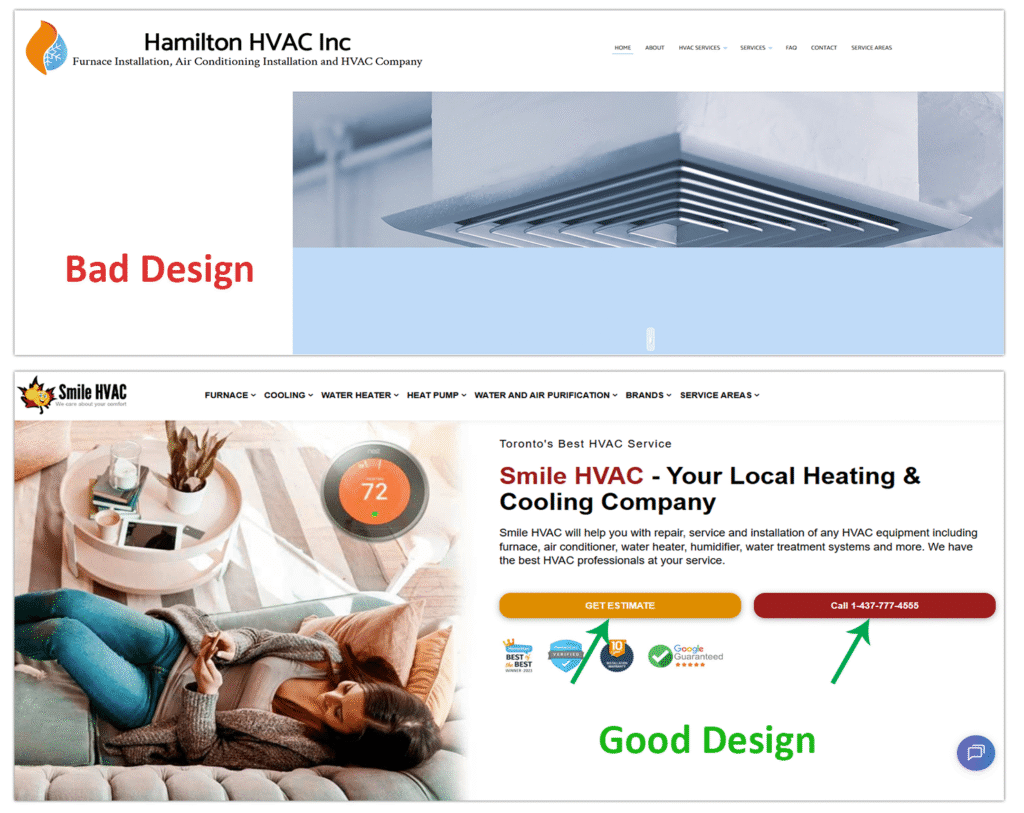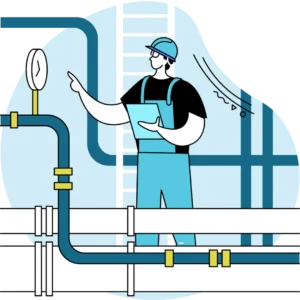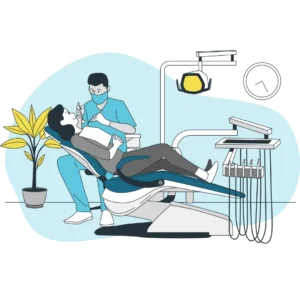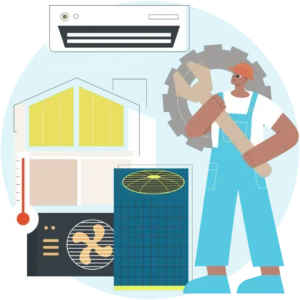Your HVAC website is often the first impression potential customers have of your business.
In fact, 75% of people judge a company’s credibility based on its website design, and 88% of online consumers are less likely to return to a site after a bad experience.
That means if your site looks outdated, loads slowly, or lacks clear information, you could be losing valuable leads before they even call.
When a homeowner’s furnace fails in the middle of winter or an AC unit breaks down in July, they’ll search online for help and your website can be the deciding factor between getting the call or losing the lead.
A high-performing HVAC website isn’t just a digital brochure; it’s a marketing engine built to attract, engage, and convert visitors into paying customers.
This guide will show you how to design an HVAC website from a marketing perspective.
We’ll break down the must-have design elements, SEO strategies, and conversion-focused features that ensure your site drives real business results.
Why Your HVAC Website Matters More Than Ever

Your website isn’t just a digital business card, it’s the foundation of your HVAC marketing.
Nearly every customer will visit your site before deciding whether to call, and the impression they get in those first few seconds can make or break the sale.
A strong HVAC website builds trust, captures quality leads, and supports all of your marketing campaigns.
The Role of Your Website in HVAC Marketing
All your marketing from Google Ads to social media posts eventually funnels customers to your website.
If the site isn’t designed to guide visitors toward booking a service or requesting a quote, your campaigns won’t deliver their full return on investment.
First Impressions Define Trust
Research shows 75% of people judge a company’s credibility based on website design.
For homeowners in urgent need of HVAC services, a polished, easy-to-navigate site can quickly signal professionalism and reliability, while a poorly designed site drives them straight to competitors.
A 24/7 Sales and Lead Generation Machine
Your HVAC website works around the clock, even when your office is closed.
With features like online booking, live chat, and click-to-call buttons, it can convert late-night and weekend searches into real leads ensuring you never miss opportunities.
Core Elements of a High-Converting HVAC Website
A high-performing HVAC website isn’t just about looking good, it’s about guiding visitors toward taking action.
From fast load speeds to trust-building elements, the right structure and features can dramatically improve how many visitors become leads.
Here are the key elements every HVAC business should prioritize:
Mobile-First Design and Fast Load Speed

More than 60% of HVAC-related searches happen on mobile devices.
If your site isn’t mobile-friendly, you’re instantly losing customers.
Google also factors load speed into search rankings, so a slow site doesn’t just frustrate users it hurts visibility too.
Quick wins to improve performance:
- Use a responsive, mobile-first design
- Compress large images and videos
- Remove unnecessary plugins and scripts
- Aim for a load time under 3 seconds
Clear and Compelling Calls-to-Action (CTAs)
Your website should make it obvious what the visitor should do next whether that’s calling your team, booking a service, or requesting a free estimate.
Best practices for CTAs:
- Place them above the fold (visible without scrolling).
- Repeat them throughout key sections of the page.
- Use action-oriented language (“Book Service Now”, “Get a Free Quote”).
- Make buttons stand out with contrasting colors.
Dedicated Service Pages for Each Offering
Many HVAC companies lump all services onto a single page, but that’s a big mistake.
Create separate, optimized pages for core services such as:
- AC repair
- Furnace installation
- Duct cleaning
- Emergency HVAC services
This structure improves SEO by targeting specific keywords and makes it easier for customers to find exactly what they need.
Trust Signals That Build Confidence
When a homeowner chooses an HVAC provider, they’re inviting someone into their home trust matters.
Showcase credibility by including:
- Customer reviews and testimonials
- Industry certifications and licenses
- Warranty information
- Partnerships with trusted HVAC brands (Carrier, Lennox, Trane, etc.)
These small details reassure visitors that your company is professional, safe, and reliable.
SEO Strategies That Drive Quality Traffic
A great-looking HVAC website won’t generate leads if nobody can find it.
That’s where search engine optimization (SEO) comes in.
By optimizing your website for local searches, building out keyword-rich content, and structuring your pages correctly, you can ensure your business appears when homeowners are searching for HVAC services in your area.
Local SEO for HVAC Businesses
Most HVAC jobs are location-based and customers need service near them.
That makes local SEO critical. Many of the same tactics used in SEO for franchise businesses like building location-specific landing pages and optimizing Google Business Profiles also apply to HVAC companies.
To capture these leads:
- Optimize your Google Business Profile with accurate hours, services, and photos.
- Use city + service keywords (e.g., “AC repair in Toronto” instead of just “AC repair”).
- Add your name, address, and phone (NAP) consistently across directories.
- Embed a Google Map on your contact or service area page.
Stat to support: 46% of all Google searches are looking for local information.
On-Page SEO Essentials
Strong on-page SEO for HVAC helps your site rank higher for the exact services you offer. HVAC companies should focus on:
- Optimized meta titles and descriptions that include service + location.
- Header tags (H1, H2, H3) that naturally use keywords.
- Schema markup for local businesses and reviews to stand out in search results.
- Internal linking between blogs, service pages, and contact forms to guide visitors.
Content Marketing: Blogs, FAQs, and Seasonal Tips
Publishing helpful content positions your HVAC company as a trusted authority while targeting long-tail keywords. Example blog ideas:
- “Why Is My AC Blowing Warm Air? 5 Common Reasons”
- “Furnace Maintenance Checklist Before Winter”
- “How to Lower Energy Bills with Proper HVAC Care”
You can also build:
- FAQ pages: that directly answer customer questions.
Seasonal guides: to capture spikes in search traffic during summer (AC) and winter (heating). - Video content: embedded into your blogs to improve engagement.
Stat to support: Businesses with blogs generate 67% more leads per month than those without (DemandMetric).
This section balances marketing advice + SEO best practices + stats + bullets so it’s practical and evidence-backed.
Design Principles That Boost Conversions
Even if your HVAC website ranks on the first page of Google, it won’t help your business if visitors don’t feel confident enough to take action.
Good design goes beyond aesthetics; it’s about creating a user experience that feels trustworthy, easy, and persuasive.
When homeowners are stressed about a broken furnace or AC unit, they want answers quickly.
A well-designed HVAC website reduces friction and gives them a reason to call you instead of your competitors.
Above-the-Fold Essentials
The “above-the-fold” area is what visitors see immediately when your website loads, without scrolling.
This is prime real estate and often determines whether someone stays or leaves. For HVAC companies, this section should include:
- Your phone number is clearly displayed (with click-to-call enabled on mobile). Most HVAC customers are searching during an urgent situation, so make contacting you effortless.
- A clear call-to-action (CTA) such as “Book Service Now” or “Get a Free Quote Today”. This tells visitors exactly what to do next.
- Emergency service information if you offer 24/7 repairs. A badge or line like “Available 24/7 for Emergency HVAC Repairs” can win over customers who need immediate help.
- A short tagline or value proposition that sets you apart (e.g., “Trusted HVAC Experts Serving Toronto Since 2005”).
If this area is cluttered, confusing, or lacks key info, visitors are likely to bounce and call someone else.
Visual Elements That Build Trust
Design psychology plays a big role in how customers perceive your business.
Homeowners are inviting technicians into their homes, so trust is critical.
Using stock photos might save time, but they often feel generic and impersonal.
Instead, build credibility by:
- Featuring real photos of your technicians, trucks, and office. This makes your business feel approachable and authentic.
- Showcasing before-and-after project photos to demonstrate quality workmanship. For example, show a dirty, broken AC unit and the fixed one after your team’s service.
- Highlighting brand partnerships with trusted manufacturers like Carrier, Lennox, or Trane. This not only builds credibility but also signals professionalism.
- Maintaining a clean, uncluttered layout with consistent colors and typography. A disorganized site can subconsciously suggest your business is also disorganized.
First impressions form in 0.05 seconds — and visuals are a major part of that judgment.
Lead Capture Tools That Make It Easy
Even if customers trust your site, they won’t convert if contacting you feels like a chore. That’s why you need multiple, convenient ways for them to reach you:
- Click-to-call buttons: Click-to-call buttons are crucial for mobile visitors, especially during emergencies. When a furnace breaks in January, most customers won’t fill out a long form they’ll want to call instantly.
- Short, simple booking forms: asking only for essentials (name, phone, service needed). Long forms discourage submissions.
- Live chat or chatbots: these provide immediate answers, capture leads after hours, and reassure visitors who might not be ready to call. According to Forrester, adding live chat can boost conversions by up to 40%.
- Exit-intent popups: if someone is about to leave, you can offer a discount, special offer, or free consultation in exchange for their contact info.
When combined, these tools make your HVAC website work like a 24/7 sales rep always ready to answer questions, book services, and capture leads.
Marketing Integrations That Maximize ROI
A high-converting HVAC website doesn’t operate in isolation.
To get the most out of it, you need to connect it with the right marketing tools and platforms.
Integrations ensure that every lead is tracked, nurtured, and re-engaged giving you more value from each visitor who lands on your site.
CRM and Lead Tracking for HVAC Companies
Collecting leads is only the first step managing them properly is what turns inquiries into booked jobs.
By connecting your website forms and calls to a Customer Relationship Management (CRM) system, you can:
- Track where each lead came from (Google search, ad, or referral).
- Assign leads automatically to the right technician or sales rep.
- Follow up quickly with automated emails or text reminders.
- Monitor which marketing channels are driving the most revenue.
For HVAC companies, tools like ServiceTitan, Jobber, or HubSpot can integrate directly with your site, so no lead slips through the cracks.
Retargeting Strategies for Lost Visitors
Most visitors won’t convert on their first visit.
In fact, studies show it often takes 6–8 touchpoints before a customer is ready to make a decision.
That’s where retargeting comes in.
By installing tracking pixels (from Google or Meta) on your site, you can re-engage people who left without booking by showing them:
- Ads highlighting seasonal promotions (“Furnace Tune-Up – 20% Off This Month”).
- Reminders about emergency availability (“Need Fast AC Repair? We’re Available 24/7”).
- Customer testimonials or reviews to build trust.
This keeps your brand in front of potential customers until they’re ready to act.
Landing Pages for PPC Campaigns
If you’re investing in paid ads, sending traffic to your homepage is a common mistake.
Instead, create dedicated landing pages tailored to each ad campaign.
For example:
- A “New AC Installation” Google Ad should go to a page focused solely on AC installation.
- A “24/7 Emergency Repair” campaign should link to a page emphasizing fast response and emergency service.
Strong landing pages convert better because they match the visitor’s intent exactly.
Include:
- A clear headline tied to the ad copy.
- One strong call-to-action (instead of multiple links).
- Social proof like testimonials or reviews.
- A simple contact form or click-to-call button.
This approach ensures you’re not wasting money on clicks that never turn into customers.
Common Mistakes HVAC Websites Make (and How to Fix Them)
Even the most established HVAC companies often make website mistakes that silently cost them leads.
Identifying and fixing these issues can instantly improve performance without spending extra on ads.
Mistake 1: No Mobile Optimization
More than half of HVAC-related searches happen on smartphones.
If your website isn’t mobile-friendly, customers will struggle to navigate, zoom in, or fill out forms and most will simply leave.
Fix: Use a responsive, mobile-first design that automatically adjusts to different screen sizes. Test booking forms and click-to-call buttons specifically on mobile devices.
Mistake 2: Using Generic Stock Photos
Stock images may look professional, but they don’t inspire trust. Homeowners want to see the real people they’re inviting into their homes.
Fix: Invest in real photos of your technicians, trucks, and completed jobs.
This builds authenticity and helps your brand stand out from competitors who all use the same generic images.
Mistake 3: Weak or Hidden Calls-to-Action
A common mistake is burying CTAs at the bottom of the page or making them too subtle. Without clear direction, visitors won’t know what to do next.
Fix: Place bold, action-driven CTAs (like “Book Your Service Now” or “Request a Free Estimate”) at the top of the page and repeat them throughout. Use contrasting colors so they stand out.
Mistake 4: Overloading the Homepage
Some HVAC websites cram too much text, multiple offers, and distracting visuals onto the homepage.
This overwhelms visitors and makes it harder to find important information.
Fix: Simplify your layout. Focus on your top services, value proposition, and one or two clear CTAs. Use internal links to guide visitors to detailed service pages.
Mistake 5: Ignoring Page Speed
A slow-loading website frustrates users and hurts SEO rankings. Research shows that a 1-second delay in page load time can reduce conversions by 20% (Portent).
Fix: Compress large files, optimize images, and use reliable hosting to ensure your site loads in under three seconds.
Real-World Examples of High-Converting HVAC Websites
Sometimes the best way to understand what works is to see it in action.
High-converting HVAC websites share a few common traits: clear design, easy navigation, and strong conversion elements.
Let’s look at what sets them apart.
Example 1: Before-and-After Redesign
One HVAC company had a cluttered, outdated website with slow load times and no clear CTAs.
Visitors had to scroll endlessly to find contact information, leading to high bounce rates.
After a redesign that added:
- A clean, mobile-friendly layout
- Prominent “Book Service Now” buttons
- Dedicated service pages for AC, heating, and duct cleaning
- Google review highlights on the homepage
Example 2: Local-Focused HVAC Website
Another HVAC business serving multiple cities was struggling to rank locally.
Their website only had one generic service page.
After building city-specific landing pages (e.g., “Furnace Repair in Toronto” and “AC Installation in Vaughan”), they began appearing in the top three Google results for each service area.
The result? A steady flow of organic leads without extra ad spend.
Example 3: Trust-Driven Design
A smaller HVAC contractor built credibility by focusing on transparency. Their site featured:
- Team photos instead of stock images
- A “Meet Our Technicians” page with bios
- Certifications, warranties, and financing options clearly displayed
This trust-first approach increased call volume by 30% in just two months, proving that even small details can boost conversions.
Conclusion
Your HVAC website isn’t just a digital presence it’s your most powerful marketing tool.
A well-designed site builds trust instantly, captures leads 24/7, and supports every other campaign you run, from SEO to paid ads.
By focusing on the core elements of speed, usability, trust signals, SEO, and smart integrations, you can transform your website into a lead-generating machine.
The difference between a site that simply exists and one that converts is huge.
While one loses potential customers to competitors, the other works around the clock to bring in new business.
For HVAC companies looking to grow in today’s competitive market, investing in a high-converting website is no longer optional, it’s essential.
Ready to turn your HVAC website into a customer-generating powerhouse?
At Macro Digital, we specialize in designing websites that don’t just look good they deliver measurable results.
From SEO optimization to conversion-focused design, we help HVAC companies attract more traffic, convert more leads, and grow their business.
FAQs
What should every HVAC website include?
An HVAC website should include mobile-friendly design, clear calls-to-action (CTAs), dedicated service pages (e.g., AC repair, furnace installation), trust signals like reviews and certifications, and easy lead capture options such as click-to-call buttons or booking forms.
How much does it cost to build an HVAC website?
The cost of building an HVAC website varies depending on design complexity and features.
A simple, template-based site might cost $2,000–$5,000, while a fully custom, SEO-optimized site with integrations like CRM and online booking can range from $5,000–$15,000+.
How do I generate more HVAC leads from my website?
You can generate more HVAC leads by combining local SEO, conversion-focused design (strong CTAs, live chat, short forms), and marketing integrations like retargeting ads.
Highlighting reviews and offering special promotions can also boost conversions.
What’s the best way to improve my HVAC website’s SEO?
Start with on-page optimization, write keyword-rich titles and meta descriptions, build separate pages for each service, and add schema markup.
Pair this with local SEO tactics like optimizing your Google Business Profile and creating location-specific landing pages.
Regularly publishing helpful content, like seasonal maintenance tips, also improves rankings.




